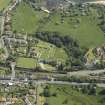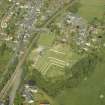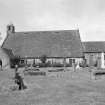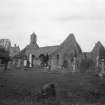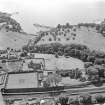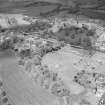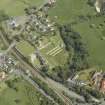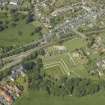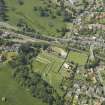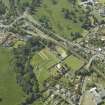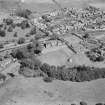Following the launch of trove.scot in February 2025 we are now planning the retiral of some of our webservices. Canmore will be switched off on 24th June 2025. Information about the closure can be found on the HES website: Retiral of HES web services | Historic Environment Scotland
Aberdour, Hawkcraig Road, St Fillan's Church
Church (Medieval)
Site Name Aberdour, Hawkcraig Road, St Fillan's Church
Classification Church (Medieval)
Alternative Name(s) Aberdour Parish Church; Aberdour Kirk, Memorial To T Col G C T Keyes Vc Mc Croix De Guerre
Canmore ID 50804
Site Number NT18NE 10
NGR NT 19320 85468
Datum OSGB36 - NGR
Permalink http://canmore.org.uk/site/50804
- Council Fife
- Parish Aberdour (Dunfermline)
- Former Region Fife
- Former District Dunfermline
- Former County Fife
NT18NE 10.00 19320 85468
(NT 1932 8546) St Fillan's Church (NAT) (AD 1178)
(NT 1937 8542) Well (NR) (site of)
OS 25" map (1964)
NT18NE 10.01 NT 1937 8542 Well
NT18NE 10.02 NT 193 854 Churchyard
Aberdour parish church, dedicated to St Fillan, was granted to Inchcolm Abbey in 1123-4 first mentioned in 1178. Aisles were added in the 16th and 17th centuries, when alterations were also made. A new church was built at Wester Aberdour in 1796-8, and this church left roofless until 1925-6 when it was restored, services being resumed in the latter year. St Fillan's Well, also referred to as "Pilgrims' Well", nearby, was visited by pilgrims (see NT18NE 14). This is probably the same well as the one, now filled up, which was situated 30 yds SE of the SE corner of the old churchyard, and was visited at the end of the 18th century by people with eye troubles.
W Ross 1862; D MacGibbon and T Ross 1887; H Scott (Fasti Eccles) 1925; RCAHMS 1933, visited 1928; H Scott 1950; M R Apted 1966.
St Fillan's Church is still in use. The site of the well, at NT 1937 8542, was pointed out by the custodian of Aberdour Castle who stated that it was probably a spring as it still issues at certain times.
Visited by OS (AC), 11 March 1959
No change to previous field report.
Visited by OS (BS), 17 December 1975
Built into the E wall of the porch of the church at Aberdour, is part of a carved stone, possibly a cross base on which the lowest postion (probably feet or foot and tail) of interlaced animal decoration is carved in relief.
(Slide and sketch with FAI: FAI No. 70/9/1).
E Proudfoot and B Proudfoot 1987.
Restored 1926 W. Williamson Arch. D.H.L.
REFERENCE
SCOTTISH RECORD OFFICE
Building the new Church.
The Heritors have adopted the plan used for the Church of Dyke.
The new Church is to be built at Wester Aberdour. The Heritors have decided to advertise for tradesmen. The Old Church is to remain until the new one is built.
25 March. Letter Robert Beatson to the Earl of Morton.
1787
GD150/2407/20
Estimates for building the new Church. Seven estimates have been given in for building the Church but several of them appear very high. They range from &585 to ?752.
Robert Beatson considers ?500 sufficient for a Chruch built on the plan of the Kirk of Dyke.
Letter robert Beatson to the Earl of Morton
N.D.(1789)
GD150/2407
Construction of a vault and building of a loft above the vault in Aberdour Kirk.
Masons' Quarriers 'Wrights' and Labourers' Day Book
1749
GD150/2394/6
Alterations to the doorways of the kirk. The masons are occupied in building up the South Porch Door and widening the East Door.
Masons' Quarriers' and Labourers' Day Book.
1749
GD150/2394/6
Payment requested for building Aberdour Church. Mr Wilson who built the Church begs 'to have a meeting of the Heritors to take the Church of his hand and assess themselves for his payment? (Alexander) Laing, Architect, (0.18,23) was acquainted with the problems that had been attended with much trouble and expense'.
Letter Hugh Bremner to the Earl of Morton.
20 Februrary 1790
GD150/3505/15
Building of a loft in Aberdour Church. Petition from the Hammerment of Aberdour to the Earls of Morton and Moray.
They ask permission to erect a loft for a seat within the Church of Aberdour either in the NE part or any other part within the Church that their Lordships shall order.
1727
GD150/2404/24
Slating the Church roof and alterations to three of the windows.
Sums paid to tradesmen for work and materials.
1724-1728
GD150/2410/21
Repair of kirk. Receipted account for slater work.
1754 and 1735
GD150/2413/15
Account of the expense of repairing the kirk at Aberdour.
Receipts for payment for materials and for mason wright and slater work. They amount to ?40.9.41/2.
1744-45
GD150/2428/3/23-36
St Fillan’s Parish Church Aberdour was recorded as part of the Threatened Buildings Survey on 10th May 2023. The survey was prompted by the proposed closure of the church as outlined in the Fife Presbytery Mission Plan 2022. The church founded in the 12th century is described in the RCAHMS Inventory of Fife item 15 and the entry is dated 10th July 1928. The church had been vacated in 1790 when the new church was built on the Main Street in Aberdour (see Canmore site 101237). Rev. Robert Johnstone led the campaign to restore the medieval church and re-occupy it which was re-opened and re-dedicated on 7th July 1926. William Williamson (1871-1952) was the architect of the restoration. Scott Morton & Co made the communion table and pulpit 1926 and the nave chairs were made by the Design Furniture Group 1973. The stained glass includes six windows by Alexander Strachan c.1930.
Field Visit (11 June 1928)
St. Fillan's Church, Aberdour.
This old parish church, for long disused and ruinous but recently restored for worship, stands within its churchyard at the eastern end of the village beside the Castle (No. 17). The approach to it passes through the remains of a 17th century structure, evidently part of the Castle property. The church is a Romanesque building of two divisions, consisting of nave and chancel, both square-ended. It was considerably altered in the 16th century when the nave was enlarged by the addition of a south aisle entered through a south porch, while in the 17th century a low transeptal aisle was added on the north side.
The earliest masonry is cubical ashlar. The chancel is low-set and is mainly original, but the south door dates only from the 17th century. There is one window to the north and a second to the east and two others (which have been considerably restored) to the south, all being narrow lights with semi-circular heads chamfered at the arris. In the nave the eastern window of the north wall is original, but the western window is formed from a doorway of about the 16th century, by the insertion of a glazed case; a window above the doorway is a 17th-century insertion. The transeptal aisle is mainly built of ashlar. In its gable lie the entrance and a window. A moulded string-course, running above the former, abuts on the moulded margin of the latter, above which is a triangular pediment bearing two monograms of initials which are, apparently, D.P.C.M., with the date 1608, the family being that of Phin of Whitehill (1).
Both gables of the nave were raised in the 16th century, for the roof of that time, like the modern one, was set at a steeper pitch than the Romanesque roof, and the west gable was further altered by the insertion of a 16th-century two-light Gothic window. So much masonry had then to be removed that the upper part of the gable has virtually been rebuilt; the lower part, however, as seen from the inside, is original. The gable is surmounted by a belfry dated 1588, in which hangs the bell of Dalgety Church (NT18SE 2). The walls of the south aisle, except the east gable which was rebuilt in the 17th century, date from the 16th century, but they include, like the porch, a considerable amount of modern work, these parts having been greatly destroyed prior to restoration. The aisle had a western window of the 16th century, which in the 17th century was partly demolished and was replaced by a doorway intended to give admission to an internal gallery at the west end of the church. With the removal of the gallery, however, this doorway was built up. The south porch is slightly later than the aisle. Its gable, containing the arched outer entrance, is mainly original and the lintelled entrance in the church wall is entirely so. On the eastern side of the latter a roughly formed benatura was constructed when the porch was added.
The interior of the church (Fig. 93) is plain. There is some evidence to suggest that the floor of the nave was at one time at a higher level than at present, and sufficient evidence to prove that the aisle arcade has been inserted in a pre-existing Romanesque wall. The arcade is three bays in length and stops short of the west gable. Its piers are circular and have simply-moulded capitals and bases. The arches are built in a single order and are chamfered. The grooving on the south side of the Romanesque masonry adjoining the west ern respond may indicate the position of the original entrance to the church. The western end of the nave was at one time occupied by a low burial-vault, and, when this was removed, Romanesque masonry was exposed beneath the sill of the west window, showing that the nave had not been lengthened. Above the vault lay the gallery previously mentioned, an outer entrance to which had to be made in the west wall of the aisle, a door which is now filled in having to be opened from the aisle to give access. The transeptal aisle is vaulted and opens to the nave through an archway, the sill being some 3 feet 6 inches above the floor of the nave and at the same level as the sills of the late doorway on its westside and of a Romanesque doorway, of which only part remains, on the east. The Romanesque windows are widely splayed internally and have semi-circular rear-arches and stepped breasts.
The chancel arch is semi-circular and is built in two unmoulded orders enclosed towards the nave by a trigonal hood-mould. The jambs also are in two orders, the inner being a semishaft. Abacus and capital, respectively rectangular and chamfered, are continued as an impost. The bases are missing, but there are remains of a chamfered sur-base. The floor of the chancel is elevated above that of the nave while that of the sanctuary is higher still. Beneath the north window a locker has been inserted. It bears on the lintel the date 1670 and initials, apparently M.W.A. The fragment of dog-tooth ornament lying at present in the locker was brought recently from Iona.
FONT. An octagonal basin of stone, measuring 2 feet 1 ½ inches in diameter by 1 foot ½ inch in height, was unearthed during the restoration of the church and has been erected on a modern shaft.
CONSECRATION CROSS. On the north wall of the sanctuary, west of the window, is a consecration cross with a diameter of 1 foot 2 ½ inches.
SEPULCHRAL MONUMENTS.- On the outside of the south wall of the aisle is a mural tablet to Robert Blair, minister at St. Andrews and at one time chaplain to Charles I, who died in 1666. Another stone, lying near the west wall of the churchyard, commemorates Major Francis Cooke WHO WAS A MARTIAL MAN FOR THE SPACE OF 26 YEIRS AND DECEASED THE 10 DECEMB(E)R 1646 BEING OF THE AGE OF 42 YEIRS. The lower part of this stone bears a shield with a sword above it and the scabbard below. The shield bears: A chevron between three combs of six teeth, all within seven roses. Flanking it are the initials F.[C]., M.C., I, and M.S. On the right side of the shield is a later inscription.
Beneath the west window is an incomplete slab, apparently of the 17th century, which bears the following lines: PANS*. O. PILGRIM / THAT. PASSITH . BY. THIS. WAY/VPON . THYN . END /AND . THOV . SAL. FEAR. TO . SIN/AND . THINK. ALSO/VPON . THE . LATTER. DAY/WHEN . THOV . TO . GOD . MAN**· COVNT/THEN . BEST . THOV . NOW. BEGIN.
RCAHMS 1933, visited 11 June 1928
(1) Aberdour and Inchcolme, by Wm. Ross, LL.D., p. 32
* That is, ‘meditate’ (Fr. pense)
** That is, ‘must’
Aerial Photography (1966)
Oblique aerial photographs of Aberdour, FIfe, photographed by John Dewar in 1966.
Aerial Photography (1966)
Oblique aerial photographs of Aberdour, Fife, photographed by John Dewar in 1966.





























































































